Extra EA-300
The Extra Flugzeugbau EA300 is a two-seat aerobatic monoplane capable of Unlimited category competition. It was designed in 1987 by Walter Extra, a German aerobatic pilot, and built by Extra Flugzeugbau.
| EA300 | |
|---|---|
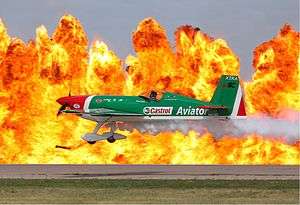 | |
| Role | Aerobatic monoplane |
| National origin | Germany |
| Manufacturer | Extra Flugzeugbau |
| Designer | Walter Extra |
| First flight | May 1988 |
| Status | Active |
| Produced | 1988-present |
Design and development
Design of the Extra 300 was based on the Extra 230, an early 1980s monoplane having a wing made of wood. The Extra 300 has a welded steel tube fuselage covered in aluminium and fabric. The midset wing has a carbon fiber composite spar and carbon composite skins.[1] A symmetrical airfoil, mounted with a zero angle of incidence, provides equal performance in both upright and inverted flight. The landing gear is fixed taildragger style with composite main legs and fiberglass wheel pants. The powerplant is a fuel-injected Lycoming AEIO-540 which produces 300 horsepower (224 kW).
The first two-seat Extra 300 made its maiden flight on 6 May 1988, with German type certification following on 16 May 1990. The single-seat Extra 300S flew on 4 March 1992.[1]
The Extra 300 is stressed for ±10 G with one person on board and ±8 G with two. Some Extra 300s are certified in the experimental category in the U.S., while others are certified in the aerobatic category.[2]
_operated_by_Attitude_Aerobatics%2C_Perth%2C_Western_Australia.jpg)
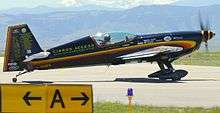
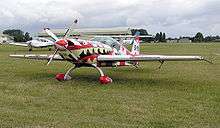
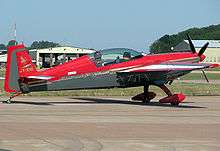
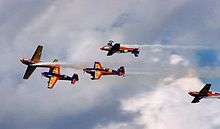
Variants
- 300
- Original two-seat version[3]
- 300S
- The 300S is a single-seat version, with a wingspan reduced by 50 cm (19 1⁄2 in), and fitted with larger ailerons.[1][3]
- 330SX
- The Extra 330SX was a custom development of the 300S with a wider-chord rudder, a larger elevator, and a more powerful Lycoming AEIO-580 powerplant producing 330 hp (250 kW). Some 300Ss were sold with the "bigger tail" of the 330SX. The 330SX was later replaced by the 330SC.
- 300SP
- The 300SP is a performance version of the 300S single-seater. Weight was reduced, and the tail of the 330SX installed.[4] It is discontinued, being replaced by the 330SC.
- 300SHP
- The 300SHP (HP = high performance) is an uncertified version of the 300SP with a Lycoming AEIO-580 engine.
- 300SR
- The Extra 300SR is a modified aircraft using a specially designed high-lift wing for the Red Bull Air Race World Series.
- 300L
- The Extra 300L is a Lycoming AEIO-540-powered two-seat aircraft, with low-mounted wing and shorter fuselage.[3] More Extra 300L ("L" is a two-seater version) aircraft have been produced than any other model. Its wing is mounted at the bottom of the fuselage, with its span reduced from 26 to 24 ft (7.9 to 7.3 m). Improved ailerons boost the 300L's roll rate to 400° per second. All 300Ls are fully certified under FAA and European Joint Aviation Authorities regulations.
- 300LP
- The 300LP (P = performance) is a reduced-weight version of the 300L, redesigned for better performance in competitions and airshows.
- 330SC
- The Extra 330SC is a Lycoming AEIO-580-powered single-seat aircraft with improved roll rate and easier roll stops, designed specifically for Unlimited category competition. It is the only single-seater aerobatic aircraft currently being built by Extra.
- 330LX
- The Extra 330LX is a Lycoming AEIO-580-powered two-seat aircraft.
- 330LT
- The Extra 330LT is a Lycoming AEIO-580 powered two-seat aircraft, adapted for touring. It has an EFIS cockpit and a reduced roll rate in comparison with the 330LX.
- 330LE
- The Extra 330LE is a one-seat aircraft powered by an electric engine made by Siemens, delivering 260 kW, for 50 kg. On Thursday, March 23, 2017, the Extra 330LE set two new speed records, said Siemens : "At the Dinslaken Schwarze Heide airfield in Germany, the electric aircraft reached a top speed of around 340 kilometers per hour (km/h) over a distance of three kilometers. On Friday, March 24, 2017, the Extra 330LE gave another premiere performance by becoming the world's first electric aircraft to tow a glider into the sky". [5]
Operators
Civilian
- Aviation Performance Solutions is the largest user of Extra 300Ls, with a fleet of eight aircraft used for upset prevention and recovery training (UPRT) in the United States at its bases in Mesa, Arizona and Arlington, Texas.[6][7]
- The Blades private aerobatic team displays at air shows in Britain using a team of four Extra 300LPs. It offers passenger flights to members of the public and aerobatic training for pilots.[8]
- Patty Wagstaff has flown the Extra 230, 260, and various models of the 300 in aerobatic competitions and airshows since the mid-1980s.[9]
- Finnish Aviation Academy has one aircraft in operation for upset recovery training.
- Romanian Airclub - Hawks of Romania aerobatic team,[10] using a fleet of 5 EA300L and 3 EA330SC, as of 2018.[11]
Military operators
- Chilean Air Force - The Escuadrilla de Alta Acrobacia Halcones ("Chilean Air force High Aerobatics Squadron, called "Hawks") has used the 300L variant since 2003.
- Royal Jordanian Air Force
- The Royal Jordanian Falcons, the aerobatic demonstration team of Royal Jordanian Airlines and the official national aerobatic team of Jordan, perform in a formation of four Extra 300s.
- The Kris Sakti, the Royal Malaysian Air Force aerobatic demonstration team
Specifications (EA-300LP)
Data from EXTRA 300LP[12]
General characteristics
- Crew: 1 or 2
- Length: 6.9 m (22 ft 8 in)
- Wingspan: 8 m (26 ft 3 in)
- Height: 2.6 m (8 ft 6 in)
- Wing area: 10.7 m2 (115 sq ft)
- Airfoil: root: MA 15S ; tip: MA 12S[13]
- Empty weight: 660 kg (1,455 lb) equipped
- Max takeoff weight: 950 kg (2,094 lb) 2-pilot normal (+6g / -3g)
- 870 kg (1,918 lb) 2-pilot aerobatic (+8g / -8g)
- 820 kg (1,808 lb) 1-pilot aerobatic (+10g / -10g)
- Fuel capacity: 189 l (50 US gal; 42 imp gal) (usable normal: 187 l (49 US gal; 41 imp gal) ; usable aerobatic 67 l (18 US gal; 15 imp gal))
- Powerplant: 1 × Lycoming AEIO-540-L1B5 6-cylinder air-cooled horizontally-opposed piston engine, 224 kW (300 hp)
- Propellers: 3 or 4-bladed MT-Propeller composite constant-speed propeller
Performance
- Cruise speed: 317 km/h (197 mph, 171 kn)
- Stall speed: 102 km/h (63 mph, 55 kn) (VS) at 820 kg (1,808 lb)
- 111 km/h (69 mph; 60 kn) at 950 kg (2,094 lb)
- Never exceed speed: 407 km/h (253 mph, 220 kn)
- Manoeuvring speed: (Va) 292 km/h (181 mph; 158 kn)
- Ferry range: 944 km (587 mi, 510 nmi) with auxiliary fuel
- Service ceiling: 4,875 m (15,994 ft)
- g limits: 2-pilot normal +6 -3
- 2-pilot aerobatic +8 -8
- 1-pilot aerobatic +10 -10
- Roll rate: 400°/s
- Rate of climb: 16 m/s (3,100 ft/min)
- Power/mass: 3.6 kg/kW (5.9 lb/hp) in typical solo configuration
See also
Related development
- Extra 200
Aircraft of comparable role, configuration and era
- Mudry CAP 230
- MX Aircraft MX2
- Sukhoi Su-26
- Sukhoi Su-29
- Sukhoi Su-31
- Corvus Racer 540
- XtremeAir Sbach 342 (XA 42)
- Zivko Edge 540
- Zlín Z-50
References
- Notes
- Lambert 1993, p. 100.
- Wagstaff, Patty (2009). "Ask the Expert". Archived from the original on 2009-02-10. Retrieved 2009-01-03.
- Taylor 1999, p. 426.
- Extra Aircraft (2009). "EA-300SP". Archived from the original on 2008-07-08. Retrieved 2009-01-03.
- "Archived copy". Archived from the original on 2017-04-06. Retrieved 2017-04-06.CS1 maint: archived copy as title (link)
- Huber, Mark (November 2, 2016). "Bombardier Teams with APS on Upset Recovery Course". Aviation International News. Archived from the original on August 6, 2018. Retrieved August 6, 2018.
- "Aviation Performance Solutions LLC | International Aerobatic Club". www.iac.org. International Aerobatic Club. Archived from the original on August 6, 2018. Retrieved August 6, 2018.
- The Blades Archived 2009-04-10 at the Wayback Machine official website.
- "Biography – Patty Wagstaff". p. 1. Archived from the original on 2009-03-03. Retrieved 2009-02-28.
- "Al treilea avion de inalta acrobatie pentru Aeroclubul Romaniei" (in Romanian). Aviatia Magazin. 9 November 2018. Retrieved 25 April 2020.
- "Aeroclubul României" (in Romanian). Facebook. 16 February 2020.
- "EXTRA 300LP". www.extraaircraft.com. Extra Flugzeugproduktions - und Vertriebs - GmbH. Retrieved 23 September 2019.
- Lednicer, David. "The Incomplete Guide to Airfoil Usage". m-selig.ae.illinois.edu. Retrieved 16 April 2019.
- Bibliography
- Lambert, Mark. Jane's All The World's Aircraft 1993–94. Coulsdon, UK:Jane's Data Division, 1993. ISBN 0-7106-1066-1.
- Taylor, Michael. Brassey's World Aircraft & Systems Directory 1999/2000. London:Brassey's, 1999. 1 85753 245 7.
External links
| Wikimedia Commons has media related to Extra 300. |